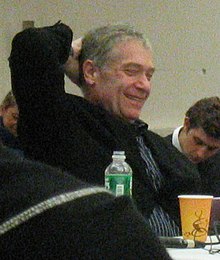
Postmodernism is a term used to refer to a variety of artistic, cultural, and philosophical movements that claim to mark a break from modernism. They have in common the conviction that it is no longer possible to rely upon previous ways of representing reality. Still, there is disagreement among experts about its more precise meaning even within narrow contexts.
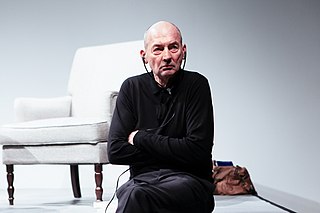
Remment Lucas Koolhaas is a Dutch architect, architectural theorist, urbanist and Professor in Practice of Architecture and Urban Design at the Graduate School of Design at Harvard University. He is often cited as a representative of Deconstructivism and is the author of Delirious New York: A Retroactive Manifesto for Manhattan.
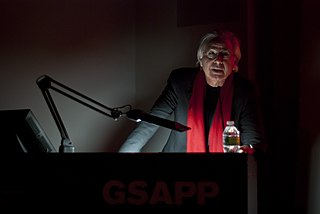
Bernard Tschumi is an architect, writer, and educator, commonly associated with deconstructivism. Son of the well-known Swiss architect Jean Tschumi and a French mother, Tschumi is a dual French-Swiss national who works and lives in New York City and Paris. He studied in Paris and at ETH in Zurich, where he received his degree in architecture in 1969.

Peter David Eisenman is an American architect, writer, and professor. Considered one of the New York Five, Eisenman is known for his high modernist and deconstructive designs, as well as for his authorship of several architectural books. His work has won him several awards, including the Wolf Prize in Arts.

The Wexner Center for the Arts is the Ohio State University's "multidisciplinary, international laboratory for the exploration and advancement of contemporary art."
Rosalind Epstein Krauss is an American art critic, art theorist and a professor at Columbia University in New York City. Krauss is known for her scholarship in 20th-century painting, sculpture and photography. As a critic and theorist she has published steadily since 1965 in Artforum,Art International and Art in America. She was associate editor of Artforum from 1971 to 1974 and has been editor of October, a journal of contemporary arts criticism and theory that she co-founded in 1976.

Constructivism is an early twentieth-century art movement founded in 1915 by Vladimir Tatlin and Alexander Rodchenko. Abstract and austere, constructivist art aimed to reflect modern industrial society and urban space. The movement rejected decorative stylization in favour of the industrial assemblage of materials. Constructivists were in favour of art for propaganda and social purposes, and were associated with Soviet socialism, the Bolsheviks and the Russian avant-garde.
The year 1904 in architecture involved some significant architectural events and new buildings.
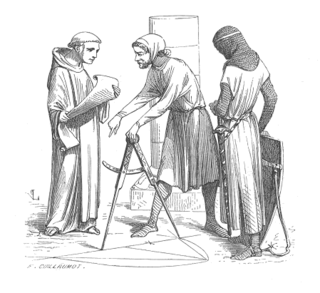
Architectural theory is the act of thinking, discussing, and writing about architecture. Architectural theory is taught in all architecture schools and is practiced by the world's leading architects. Some forms that architecture theory takes are the lecture or dialogue, the treatise or book, and the paper project or competition entry. Architectural theory is often didactic, and theorists tend to stay close to or work from within schools. It has existed in some form since antiquity, and as publishing became more common, architectural theory gained an increased richness. Books, magazines, and journals published an unprecedented number of works by architects and critics in the 20th century. As a result, styles and movements formed and dissolved much more quickly than the relatively enduring modes in earlier history. It is to be expected that the use of the internet will further the discourse on architecture in the 21st century.

Mark Antony Wigley is a New Zealand-born architect and author based in the United States. From 2004 to 2014, he was the Dean of Columbia University's Graduate School of Architecture, Planning and Preservation.

Deconstructivism is a postmodern architectural movement which appeared in the 1980s. It gives the impression of the fragmentation of the constructed building, commonly characterised by an absence of obvious harmony, continuity, or symmetry. Its name is a portmanteau of Constructivism and "Deconstruction", a form of semiotic analysis developed by the French philosopher Jacques Derrida. Architects whose work is often described as deconstructivist include Zaha Hadid, Peter Eisenman, Frank Gehry, Rem Koolhaas, Daniel Libeskind, Bernard Tschumi, and Coop Himmelb(l)au.

Michael David Sorkin was an American architectural and urban critic, designer, and educator. He was considered to be "one of architecture's most outspoken public intellectuals", a polemical voice in contemporary culture and the design of urban places at the turn of the twenty-first century. Sorkin first rose to prominence as an architectural critic for the Village Voice in New York City, a post which he held for a decade throughout the 1980s. In the ensuing years, he taught at prominent universities around the world, practiced through his eponymous firm, established a nonprofit book press, and directed the urban design program at the City College of New York. He died at age 71 from complications brought on by COVID-19 during the COVID-19 pandemic.

Alejandro Zaera Polo is a Spanish architect, theorist and founder of Alejandro Zaera-Polo & Maider Llaguno Architecture (AZPML). He was formerly dean of the Princeton University School of Architecture and of the Berlage Institute in Rotterdam.
In semiotics, Khôra is the space that gives a place for being. The term has been used in philosophy by Plato to designate a receptacle, a space, a material substratum, or an interval. In Plato's account, khôra is described as a formless interval, alike to a non-being, in between which the "Forms" were received from the intelligible realm and were "copied", shaping into the transitory forms of the sensible realm; it "gives space" and has maternal overtones :
“Moreover, a third kind is that of the Khôra (χώρας), everlasting, not admitting destruction, granting an abode to all things having generation, itself to be apprehended with nonsensation, by a sort of bastard reckoning, hardly trustworthy; and looking toward which we dream and affirm that it is necessary that all that is be somewhere in some place and occupy some khôra; and that that which is neither on earth nor anywhere in the heaven is nothing."
— Plato, Timaeus, 52a-b
"So likewise it is right that the substance which is to be fitted to receive frequently over its whole extent the copies of all things intelligible and eternal should itself, of its own nature, be void of all the forms. Wherefore, let us not speak of her that is the Mother and Receptacle of this generated world, which is perceptible by sight and all the senses, by the name of earth or air or fire or water, or any aggregates or constituents thereof: rather, if we describe her as a Kind invisible and unshaped, all-receptive, and in some most perplexing and most baffling partaking of the intelligible, we shall describe her truly."
— Plato, Timaeus, 51a
Robert E. Somol Jr. is an architectural theorist and was director of the School of Architecture at the University of Illinois at Chicago from 2007 to 2022. His writing has been centrally-linked to "post-critical" architectural theory at the turn of the 21st century; the concept is similar to that of postcritique found in literary criticism.
Diana I. Agrest is a practicing architect and urban designer and an architecture and urban design theorist, in New York City.
Kenneth Michael Hays is an American architectural historian and professor. He currently serves as Eliot Noyes Professor of Architectural Theory at Harvard University's Graduate School of Design. He is also co-director of the school's doctoral programs, namely Ph.D and DDes or Doctor of Design.

Bahram Shirdel is an Iranian architect internationally known as one of the most influential architects dealing with the interdisciplinary field of architecture and science as well as Fold/Folding Architecture. Jeffrey Kipnis, Greg Lynn, Peter Eisenman and Bahram Shirdel are among the architect-theoricians who accept topology as a cultural and scientific resource of folded, curved, undulated and twisted architectures. They are concerned with the dynamic aspects of topological geometry - that is, with the more general processes of continuous transformation.
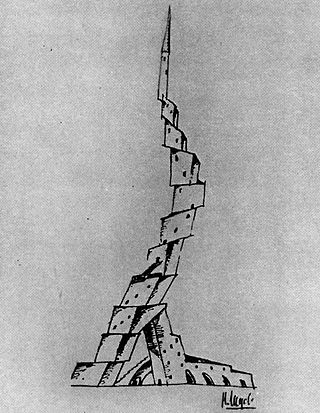
Avant-garde architecture is architecture which is innovative and radical. There have been a variety of architects and movements whose work has been characterised in this way, especially Modernism. Other examples include Constructivism, Neoplasticism, Neo-futurism, Deconstructivism, Parametricism and Expressionism.
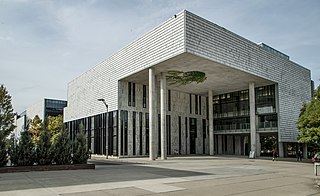
The architecture of Columbus, Ohio is represented by numerous notable architects' works, individually notable buildings, and a wide range of styles. Yost & Packard, the most prolific architects for much of the city's history, gave the city much of its eclectic and playful designs at a time when architecture tended to be busy and vibrant.
